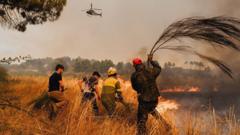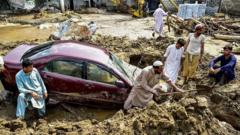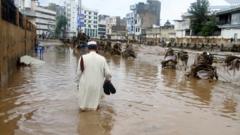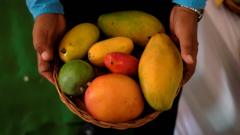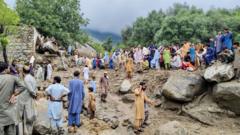With temperatures soaring close to 50°C, Indians in Sri Ganganagar, struggling daily under extreme heat, depict resilience amidst rising humidity and limited access to cooling solutions, showcasing how life is evolving in the country's increasingly hot climate.
Coping with Extreme Heat: A Day in India's Hottest Region

Coping with Extreme Heat: A Day in India's Hottest Region
Residents of Sri Ganganagar, Rajasthan face unbearable temperatures while adapting daily routines to survive the heat waves sweeping across India.
As India grapples with relentless heat waves, cities like Sri Ganganagar in the desert state of Rajasthan are at the forefront of an evolving reality. Recently, temperatures reached as high as 49 degrees Celsius (121 degrees Fahrenheit), a staggering mark that has put three-quarters of the nation's 1.4 billion population at risk of extreme heat.
The inhabitants of this region are confronting a harsh summer, where traditional lifestyles are being reshaped. With many lacking air conditioning—often an unattainable luxury—daily work persists under the relentless sun because for many, taking a day off translates to lost income. This relentless challenge compels people to seek alternative ways to cope as economic output becomes strained and medical services are stretched to their limits.
On a recent visit, we learned about the lives of the people enduring these conditions. With increasing humidity compounding the heat, residents are forced to adjust their schedules to avoid the peak sunlight hours. This small change in rhythm reveals a complex interdependence between health and work, highlighting the adaptations required just to survive.
As global temperatures rise, regions like Rajasthan serve as examples of how heat impacts daily life and economic viability, giving us insights into the broader effects of climate change that is warming the continent at double the rate of the rest of the world. The resilience demonstrated by these communities emphasizes the urgent need for large-scale action to mitigate climate impacts and develop sustainable solutions for affected regions.
The inhabitants of this region are confronting a harsh summer, where traditional lifestyles are being reshaped. With many lacking air conditioning—often an unattainable luxury—daily work persists under the relentless sun because for many, taking a day off translates to lost income. This relentless challenge compels people to seek alternative ways to cope as economic output becomes strained and medical services are stretched to their limits.
On a recent visit, we learned about the lives of the people enduring these conditions. With increasing humidity compounding the heat, residents are forced to adjust their schedules to avoid the peak sunlight hours. This small change in rhythm reveals a complex interdependence between health and work, highlighting the adaptations required just to survive.
As global temperatures rise, regions like Rajasthan serve as examples of how heat impacts daily life and economic viability, giving us insights into the broader effects of climate change that is warming the continent at double the rate of the rest of the world. The resilience demonstrated by these communities emphasizes the urgent need for large-scale action to mitigate climate impacts and develop sustainable solutions for affected regions.




